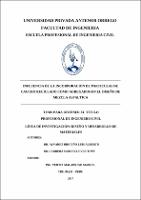| dc.contributor.advisor | Vertiz Malabrigo, Manuel | |
| dc.contributor.author | Alvarez Briceño, Luis Alberto | |
| dc.contributor.author | Carrera Sanchez, Ever Tony | |
| dc.creator | Alvarez Briceño, Luis Alberto | |
| dc.date.accessioned | 2018-02-07T16:57:12Z | |
| dc.date.available | 2018-02-07T16:57:12Z | |
| dc.date.issued | 2017 | |
| dc.identifier.uri | https://hdl.handle.net/20.500.12759/3595 | |
| dc.description.abstract | El presente estudio tiene como objetivo principal, identificar la influencia que
proporciona la incorporación de los triturados de restos de llantas conocido
comercialmente como GCR, como agregados en mezclas asfálticas. Consistió en
un desarrollo de actividades experimentales en donde inicialmente se diseñara una
dosificación analítica de materiales por medio de un tanteo indicado por la norma
MTC, para luego elaborar una serie de muestras conocidas como briquetas,
preparadas en caliente a temperaturas entre los 140° y 170° C; luego de ser
elaboradas se disponen a ensayar por medio de la máquina Marshall la cual arrojó
datos de estabilidad y flujo, siendo estos un objetivo específico de la investigación.
De esta investigación se pudo verificar que el GCR puede funcionar como agregado
de las mezclas asfálticas pero con porcentajes igual o menores al 1.5% del total de
la mezcla, teniendo en cuenta que a medida que se incorpora GCR disminuyen los
valores de estabilidad y aumenta su flujo. | es_PE |
| dc.description.abstract | This study's main objective is to identify the influence that provides the integration
of shredded tire remains commercially known as GCR, as aggregates in asphalt
mixtures. It consists of a development of experimental activities in which initially
an analytical dosage of materials is designed by a score indicated by MTP standard
2007, and then develop a set of known samples as briquettes prepared hot at
temperatures between 140 ° and 170 ° C; after being processed are arranged to be
tested by the machine who throws Marshall stability and flow data, these being a
specific target of the investigation. In this research, we found that the GCR can
function as aggregate in asphalt mixes but with percentages equal to or less than
1.5% of the mixture, taking into account that as incorporated GCR values decrease
and increases its stability flow. | en_US |
| dc.description.uri | Tesis | es_PE |
| dc.format | application/pdf | es_PE |
| dc.language.iso | spa | es_PE |
| dc.publisher | Universidad Privada Antenor Orrego | es_PE |
| dc.relation.ispartofseries | T_ING.CIVIL_1476 | |
| dc.rights | info:eu-repo/semantics/openAccess | es_PE |
| dc.rights.uri | https://creativecommons.org/licenses/by/4.0/ | es_PE |
| dc.source | Universidad Privada Antenor Orrego | es_PE |
| dc.source | Repositorio Institucional - UPAO | es_PE |
| dc.subject | Agregados | es_PE |
| dc.subject | Partículas de caucho | es_PE |
| dc.title | Influencia de la incorporación de partículas de caucho reciclado como agregados en el diseño de mezcla asfáltica | es_PE |
| dc.type | info:eu-repo/semantics/bachelorThesis | es_PE |
| thesis.degree.level | Título Profesional | es_PE |
| thesis.degree.grantor | Universidad Privada Antenor Orrego. Facultad de Ingeniería | es_PE |
| thesis.degree.name | Ingeniero Civil | es_PE |
| thesis.degree.discipline | Ingeniería Civil | es_PE |
| dc.subject.ocde | https://purl.org/pe-repo/ocde/ford#2.01.00 | |
| renati.type | https://purl.org/pe-repo/renati/type#tesis | |
| renati.level | https://purl.org/pe-repo/renati/level#tituloProfesional | |
| dc.publisher.country | PE | es_PE |


